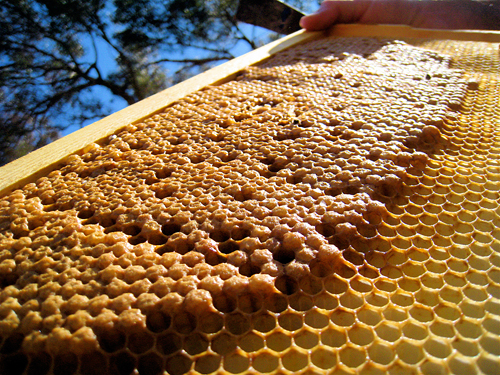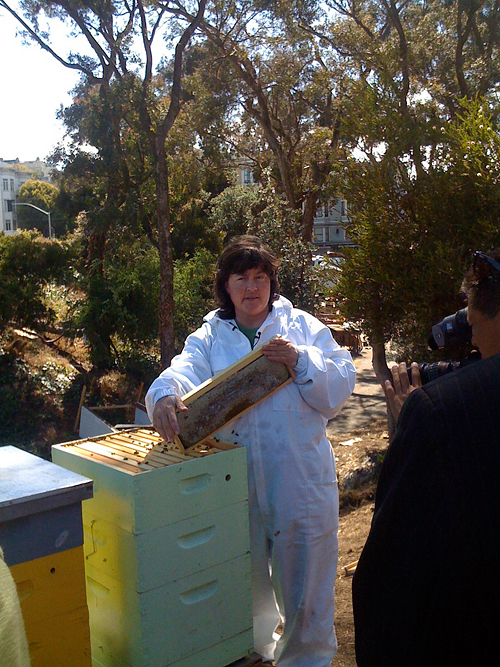"There's really no place to do hands-on bee education in the city," said Peteros last Thursday afternoon, as she and a helper scraped and scooped handfuls of the dead bees into buckets. "Nowhere that you can have the experience of going through a whole year in the life of the hive." A hands-on honey extraction class was planned for next month, after which the hives' honey would be sold as a fund-raiser for SF Bee-Cause. "We wanted to send a message that there's a place for bees in the urban environment, that pollinators are a good thing, not something to be afraid of."
Indeed, there's a big difference between mild-mannered honeybees, their equally placid native-bee brethren, and aggressive hornets and wasps. Skinny and shiny, with narrow, neon-yellow-and-black stripes, wasps and hornets are the stingers that ruin your picnic, horning in on your baloney and fruit punch. They eat meat, love sweets, and will sting repeatedly.

Hayes Valley Farm - 7/21/10 Photo by Zoey Kroll
Honeybees, on the other hand, have rounded bodies that are fuzzy and golden-striped. They eat nothing but pollen and nectar; even the most icing-piled cupcake is of no interest. Stinging anything but another bee means certain death, so they sting only as a last resort. In general, only a small number of protective guard bees directly in front of the hive have any motivation to sting. And even more importantly, they are a crucial part of our ecosystem. One third of all food plants that we eat depend on insect pollination. Even the smallest backyard garden is more fruitful when it's planted with pollinator-friendly flowers.
Before bringing in the hives, says farm co-founder Jay Rosenberg, the farm's founders attended many community and neighborhood association meetings, hoping to educate the surrounding neighbors. Rosenberg and Peteros both note that there was one person in the neighborhood who seemed to have an irrational fear and hostility to the idea of bees on the property. But with no hard evidence, they can't point a finger, although a police investigation is ongoing.
Right now, they're focusing on moving forward. A memorial is planned as part of this Sunday's usual volunteer workday at the farm. There will be something like a wake for the dead bees, and an open forum for friends of the farm to express their feelings and make suggestions. "People here have developed an affection for the bees. This will give people a chance to vent," any anger or frustration they may have, although Peteros hopes to keep the mood geared towards kindness and the need for education. She'll be bringing a gallon of honey to share, made by the "mother hive" that spawned the farm's bees.
"We're going to give the empty hive boxes to our Art Guild to decorate, to make public art for future hives," Peteros says, before picking up a frame that's glowing amber in the late-afternoon sun. "Look at all that beautiful pollen," she says, pointing out the rows of golden-tan cells ringed with milky, wax-capped honey. In one corner, somehow, a brand-new bee is being born, her curled torso struggling out of a tiny wax-walled cell.
Will bees come back to the farm? Peteros isn't sure. While the farm is fenced, it's still open space. Bees need free access to the outdoors, so enclosing them in a locked shed isn't really an option. Still, Peteros has hope.
"We're trying to turn this into something positive, make it an opportunity to do some educating en masse," says Peteros. "Everyone that learns something about bees as a result of this can become a bee ambassador."
Bee Power Granola
Adapted from Honey: from Flower to Table by Stephanie Rosenbaum
Makes approximately 6 cups
Ingredients
2 cups old-fashioned rolled oats
3/4 cup slivered almonds
1/4 teaspoon salt
1/2 teaspoon cinnamon, or to taste
¼ teaspoon nutmeg, freshly grated if possible
¼ cup flax seeds
1/2 cup hulled sunflower or pumpkin seeds
1/2 cup canola oil
1/2 cup honey
1 1/4 cups raisins, dried blueberries, dried cherries, or chopped dried apricots
2 tablespoons bee pollen, optional
Preparation
1. Preheat oven to 325ºF. Stir oats, almonds, salt, spices, flax seeds, and sunflower or pumpkin seeds together. Add oil and honey, stirring until mixture is thoroughly coated.
2. Spread mixture in a single layer on a large rimmed baking sheet. Bake, stirring occasionally, until golden brown, 30-40 minutes.
3. Remove from oven, stir in dried fruit and bee pollen, if using, and let cool. Store in an airtight container.

